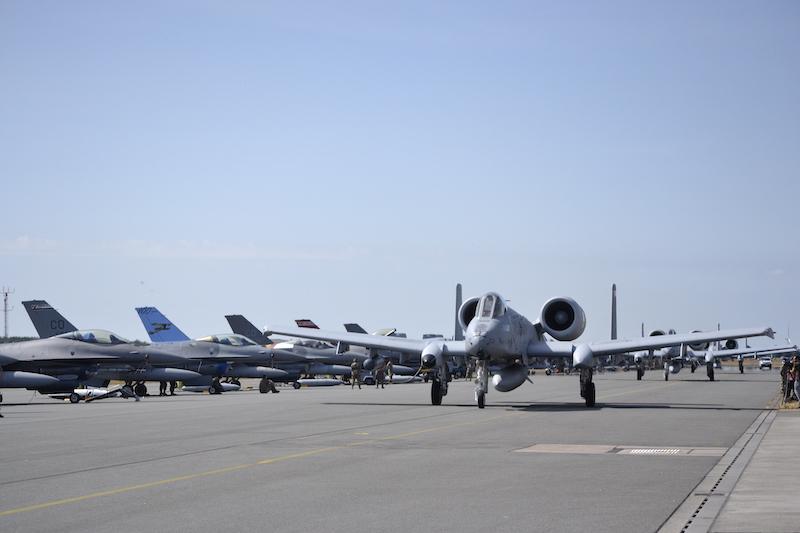
A U.S. A-10 prepares to take off for flights during NATO’s Air Defender 2023 exercise at Jagel air base, Germany, on June 22.
JAGEL AIR BASE, Germany—Twenty-five nations recently wrapped up the largest air exercise in NATO’s history, aimed at practicing all phases of an attack on a partner nation, and Russia was watching up-close.
The German and U.S. Air National Guard-led Air Defender 2023 brought together about 200 aircraft for two weeks, practicing scenarios largely around establishing air superiority and destruction of long- and medium-range surface-to-air missiles (SAMs). American and German leaders say Russia watched from the air on the eastern edge of the exercise, requiring the participants to not show all of the capabilities of the NATO aircraft.
“Anytime we come together to practice and do that stuff, if there’s real-world assets out there that are monitoring, we’re not going to show all our capabilities— nobody would,” Air National Guard Director Lt. Gen. Michael Loh tells Aviation Week. “It’s how do we conceal our capabilities ... We also had some fighters from other countries that were not anticipated, but it’s great training for our folks.”
Loh compares the interactions to how Russian fighters have harassed U.S. aircraft in Syria, which recently prompted U.S. Central Command to deploy F-22s to the region.
“So we’ve seen those same things out there before. Russia was watching," he says.
Lt. Gen. Gunter Katz, the commanding general of Germany’s Air Forces Command, says the exercise comes when the Bundeswehr is seeing swelling support for defense across the country amid concerns about Russia’s full-scale invasion of Ukraine. Although the specific scenarios planned for Air Defender were largely crafted before the invasion, Germany—a nation that historically has not shown as much pride for its military compared to others—has been supportive of the massive event.
“We always said we’ll defend every square inch of NATO territory against anybody, and we never talk about one specific country,” Katz says. “Notwithstanding that, if you talk to people on the streets, they think Russia of course ... They see the war in our neighborhood and they are concerned, and they think this is a strong signal of the ability to defend our territory, of deterrence.”
Katz declines to offer specifics of any interaction in the air, saying: “Yes, we were observed. It didn’t affect us, and that’s as much as I can say.”
U.S. aircraft participating included A-10s, C-130s, C-17s, F-15s, F-16s, F-35s, KC-135s, KC-46s and MQ-9s. Germany’s included Eurofighter Typhoons, Panavia Tornados and Airbus A400m aircraft. Others platforms included Hungarian Gripens, Greek F-16s, Finnish F/A-18s, Spanish F-18s and Turkish F-16s, among others.
One specific scenario provided during an end-of-exercise briefing showed the friendly “blue” forces using F-35s and Eurofighter Typhoons to target SAMs from afar, allowing other aircraft—such as F-16s, Gripens and A-10s—to follow on and target smaller, mobile SAMs, with attack controllers and special forces on the ground providing the targeting. The enemy side included aircraft playing roles of Su-24s and Su-30s, with simulated SA-11 and SA-15 SAMs. Others included a simulated long-range bomber strike, with a Typhoon dropping to a low altitude to simulate a cruise missile, Loh says.
The exercise provided Germany and other nations another chance to train closely with U.S. F-35As, this time from the Vermont Air National Guard. The F-35 presence in Europe is increasing, with the U.S. unit at RAF Lakenheath, England, and several other nations either establishing their fleets or looking to buy the aircraft. Berlin has finalized an €8.3 billion ($9 billion) plan to buy 35 of the Lockheed Martin jets, to be based at Buchel, Germany. The Luftwaffe will begin training on the aircraft in 2026 in the U.S., with deliveries to begin in 2027. With the fleet years away, German Air Force commander Lt. Gen. Ingo Gerhartz says the service is in the “learning phase.”
With the Bundeswehr in the early phases of growth and investment sparked by Russia’s invasion of Ukraine, the exercise was a signal that Germany can be serious about air operations on the global stage, Katz says.
“For us—for Germany—it was a signal that we’re willing to take responsibility,” he says.





